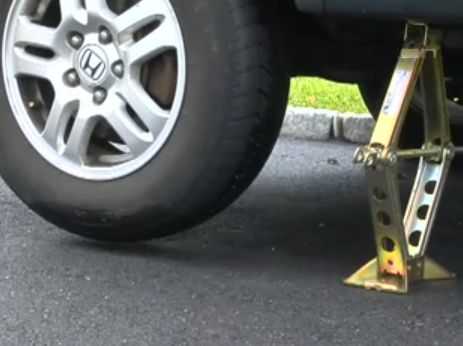Last Updated on April 21, 2024
Master the Art of Changing a Tire with Our Easy-to-Follow Instructions
Flat tires can happen at the most inconvenient times, but changing a tire can be a straightforward DIY task with some know-how and the right tools. In this step-by-step guide, we’ll walk you through the process of changing a tire so you can confidently hit the road. Whether you’re a new driver or need a refresher, read on to master the art of DIY tire replacement.
Call Roadside Emergency Assistance
What’s the safest way to change a tire when you have a flat? Have someone else do it!
If you have Emergency Roadside Assistance, now is the time to use it.
You might have a Roadside Assistance service without knowing so. Call your insurance company or check your policy. Some insurance companies include free Roadside Assistance in their policies.
Did you purchase your new car? Some automobile manufacturers give you Emergency Assistance when you buy the car. Check your vehicle policy and sale documents.
Change A Tire: A Step-by-Step DIY Guide for Drivers
Flat tires can happen when you least expect them, and knowing how to change one can be a real lifesaver. In this step-by-step guide, we’ll walk you through the process of changing a flat tire, providing clear instructions to help you get back on the road safely.
We’ve covered everything for you, from gathering the right tools to safely jacking up your car and installing the spare tire. Remember, preparation and knowledge are your best companions when faced with an unexpected flat tire situation.
Step 1: Prepare Your Tools
Before you begin, make sure you have the necessary tools on hand:
- Jack
- Lug wrench
- Spare tire
- Vehicle owner’s manual (for specific instructions)
Step 2: Find a Safe Location
Your life is more important than your tire. Make sure to pull over to a safe space or traffic before you replace your flat tire. Move your vehicle to a safe, flat area away from traffic. Ensure the parking brake is engaged, and turn on hazard lights for added safety.
Step 3: Loosen the Tire Lugs
No Roadside Assistance? It’s time to remove the tire lugs.
- Make sure your car is in “park.” You have a manual transmission; make sure it is in gear.
- Block your other ticktock, etc., to keep the car from rolling.
- Use your tire iron to loosen the wheel lugs, but don’t remove them.
- When the lugs are stuck and you need to break them free, you can elongate the tire iron with a metal pipe around its handle to increase its torque significantly.
- Turn the lugs counterclockwise to loosen them.
Step 4: Jack Up the Car
- Be careful of hot asphalt, as your jack can push down into it when carrying the weight of your car. You can spread out and diffuse that weight by placing a solid wooden board under the jack.
- Attach the jack to the specific pre-selected spots on your vehicle’s frame.
- Jack up the car. Make sure it is high enough to put on the spare, which will be taller than the flat tire because it is full of air.
Step 5: Remove the Wheel With the Flat Tire
- Remove the tire lugs.
- Remove the wheel. You may have to gently kick the tire on the left and right sides of the sidewall to loosen the wheel if it is stuck. Be very careful not to knock the car off the jack.
Step 6: Mount the New Wheel
- Clean the hub to allow the new wheel to seat correctly.
- Hold the wheel up and line up the holes with the wheel studs. Your spare can be rather heavy, so be careful.
- Push the wheel onto the studs, and screw on the lugs lightly with your fingers.
- Tighten the hubs as best you can with your hands.
- Use the tire iron to tighten them more.
- Lower the car to the ground for the final tightening. When you apply more pressure, the car’s weight on the tires will keep them from turning.
- Your wheel lugs have a specific torque rating. Since most people do not carry a torque wrench in the trunk of their car, it is general practice to tighten the lugs as much as you can.
You’re done!
Check the air in your new tire as soon as possible, and find a professional tire expert to repair your flat tire or advise you on a proper replacement tire.
Note: If your spare is a small “donut” tire, it probably has a maximum speed of 50 mph. Check the speed details on the side of the tire.
Conclusion
Changing a tire is a valuable skill every driver should have in their toolkit. With our step-by-step guide, you’ve unlocked the knowledge to tackle tire replacements on your own confidently. Remember, it’s easier than you think, and being prepared for unexpected flat tires can save you time and stress on the road.
Ready to put your newfound knowledge to use? Visit Tire Easy (https://www.tires-easy.com/) to explore a wide range of high-quality tires and essential tire maintenance tools. Don’t wait until you’re stranded with a flat—shop now and ensure you’re prepared for any tire-related situation on your journeys!
FAQs
How do you change a tire step by step?
Changing a tire is a straightforward process that can be broken down into several steps:
- Prepare Your Tools: Ensure you have a jack, lug wrench, and spare tire.
- Find a Safe Location: Move your vehicle to a safe, flat area away from traffic.
- Loosen the Lug Nuts: Use the lug wrench to loosen the lug nuts (but don’t remove them yet).
- Jack Up the Vehicle: Place the jack under it and lift it until the flat tire is off the ground.
- Remove the Lug Nuts: Fully remove the loosened lug nuts and remove the flat tire.
- Install the Spare Tire: Carefully put the spare tire in place and hand-tighten the lug nuts.
- Lower the Vehicle: Carefully lower the vehicle to the ground using the jack.
- Tighten the Lug Nuts: Use the lug wrench to tighten the nuts securely in a star or cross pattern.
- Double-Check: Ensure all lug nuts are correctly tightened, and the spare tire is secure.
- Stow Your Tools: Put your tools and the flat tire in your vehicle, and you change the e-change tires yourself.
You can change yourself if you have the necessary tools and follow proper safety precautions. It’s a valuable skill that can save you time and situations like a flat tire.
What are the five steps to change a tire?
The five essential steps to change a tire are:
- Prepare your tools and find a safe location.
- Loosen the lug nuts (but don’t remove them yet).
- Jack up the vehicle.
- Remove the flat tire and install the spare tire.
- Tighten the lug nuts, lower the car, and ensure everything is secure.
What’s the first step in changing a tire?
The first step in changing a tire is to prepare your tools and find a safe location. Ensure you have a jack, lug wrench, and spare tire ready, and move your vehicle to a flat, secure area away from traffic.










